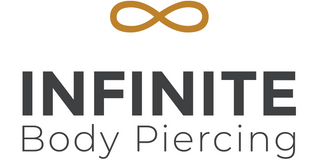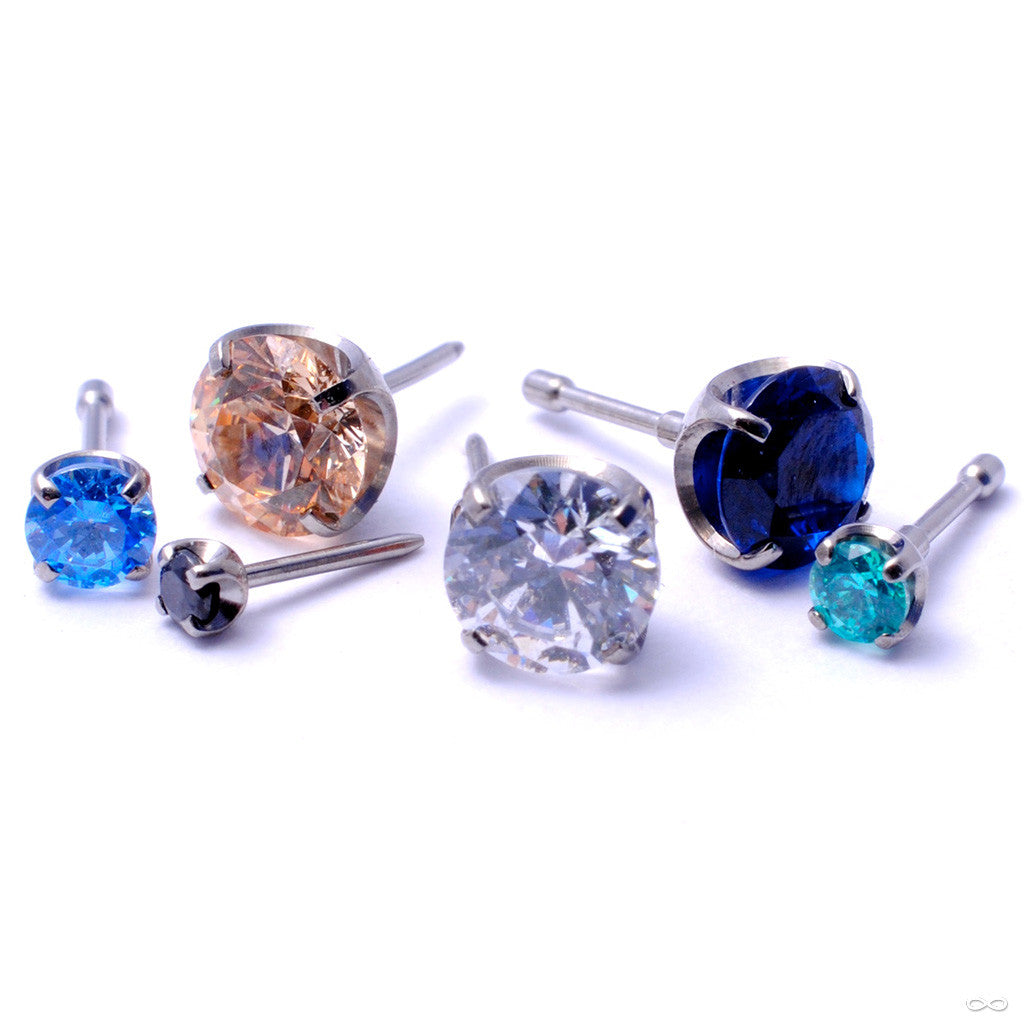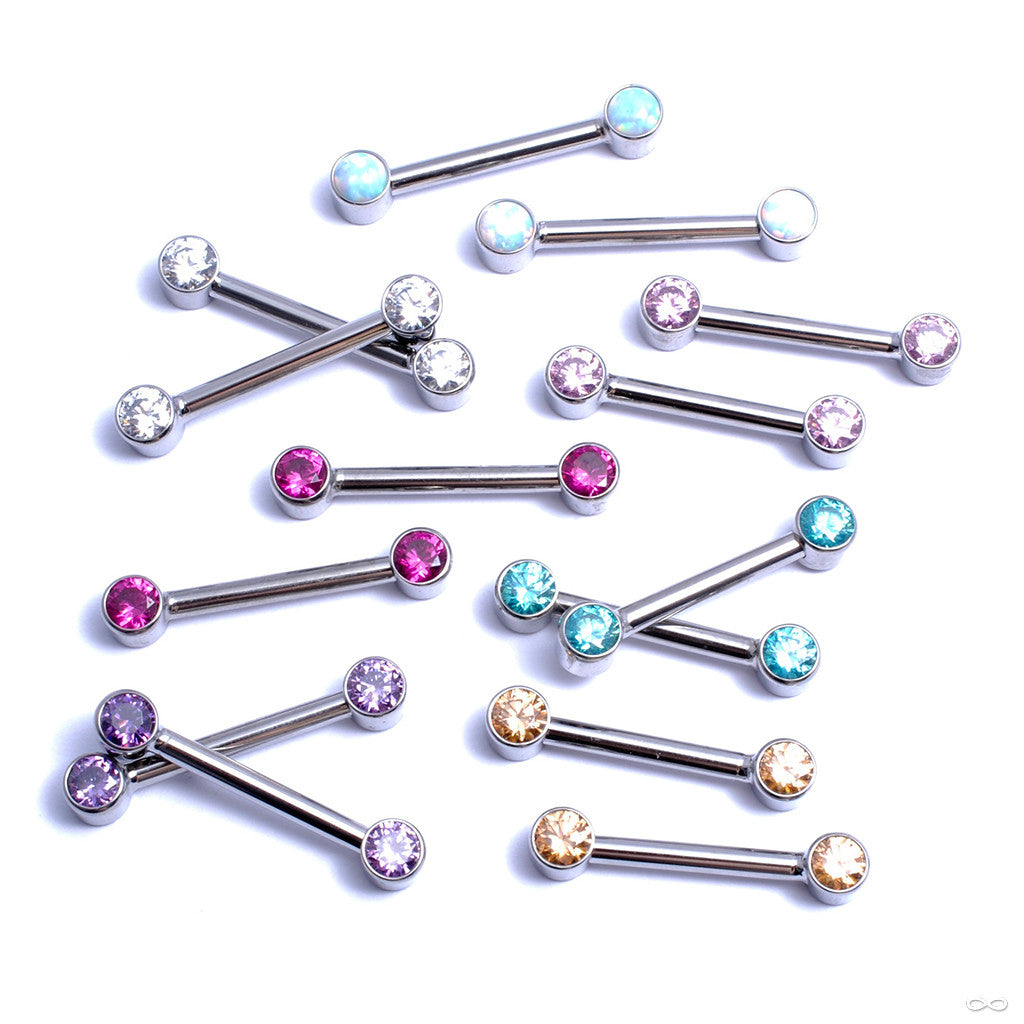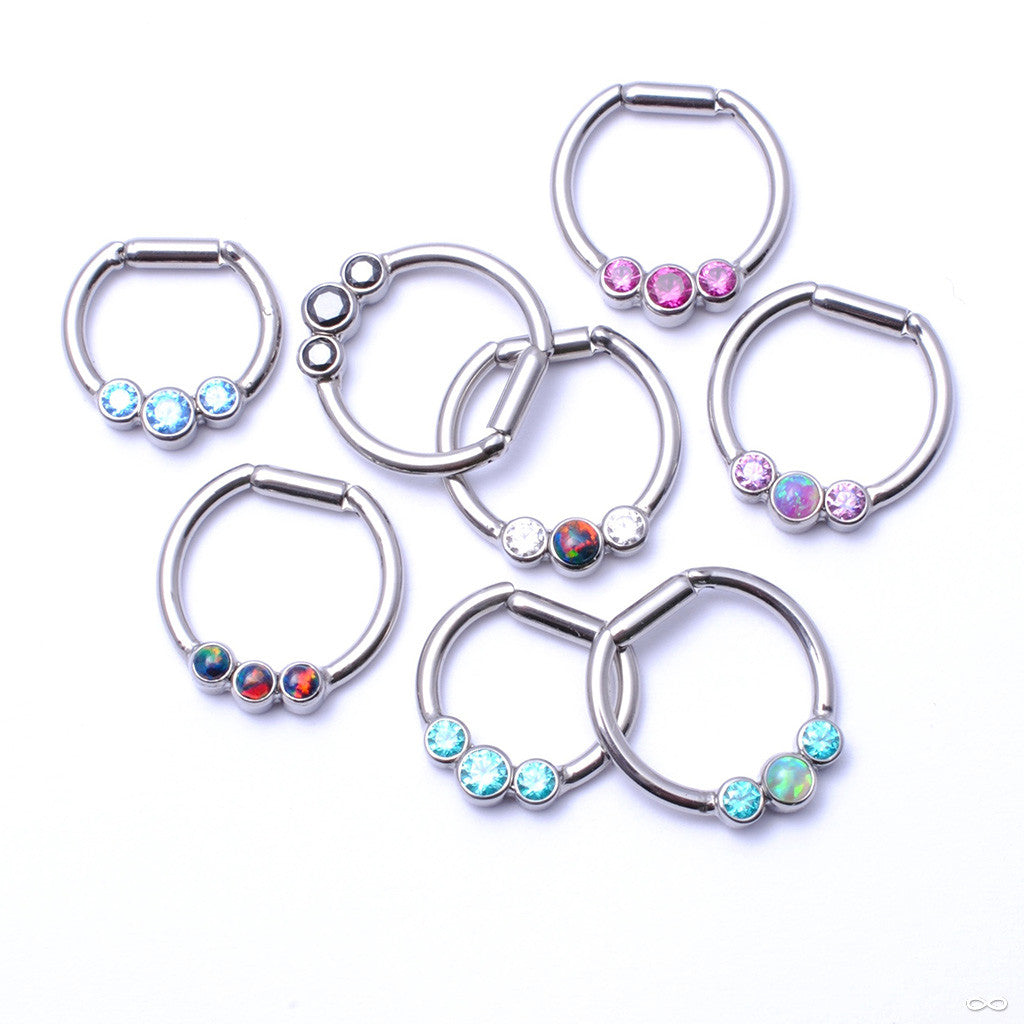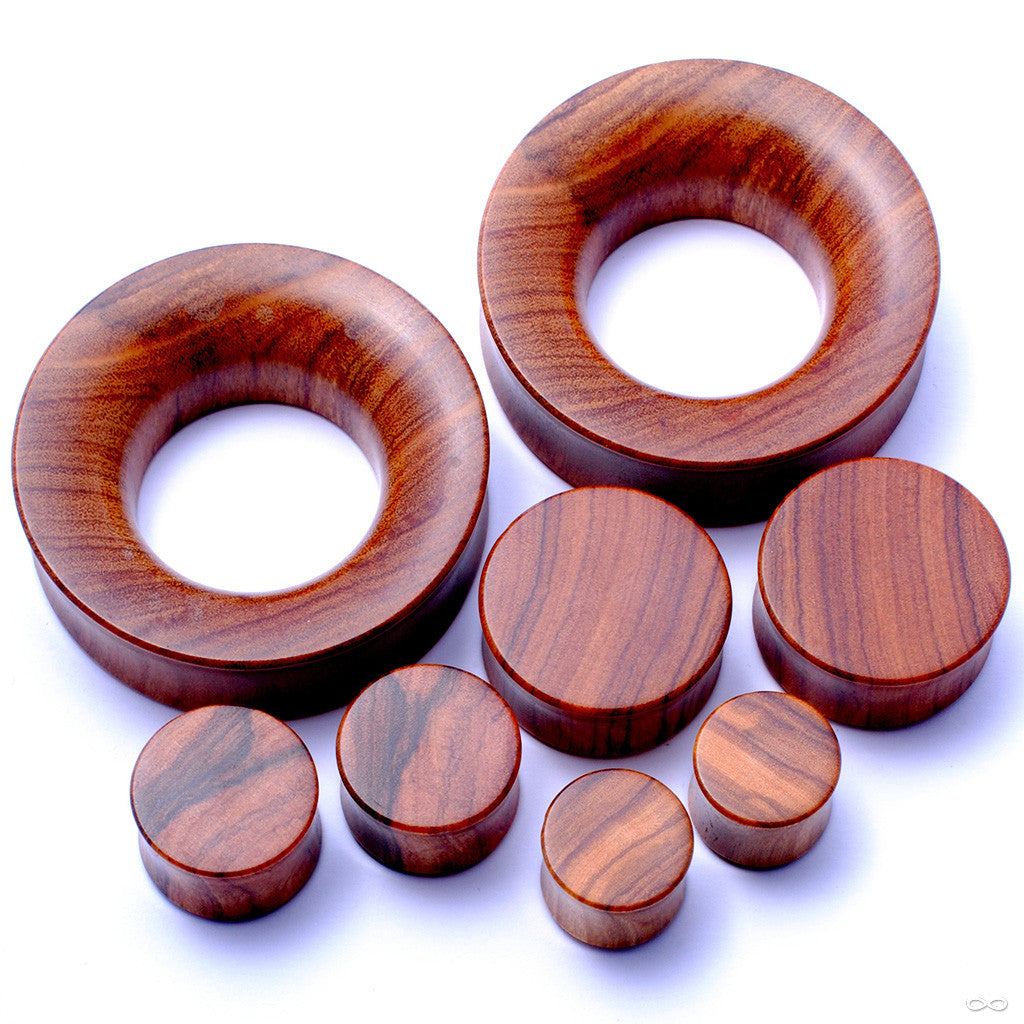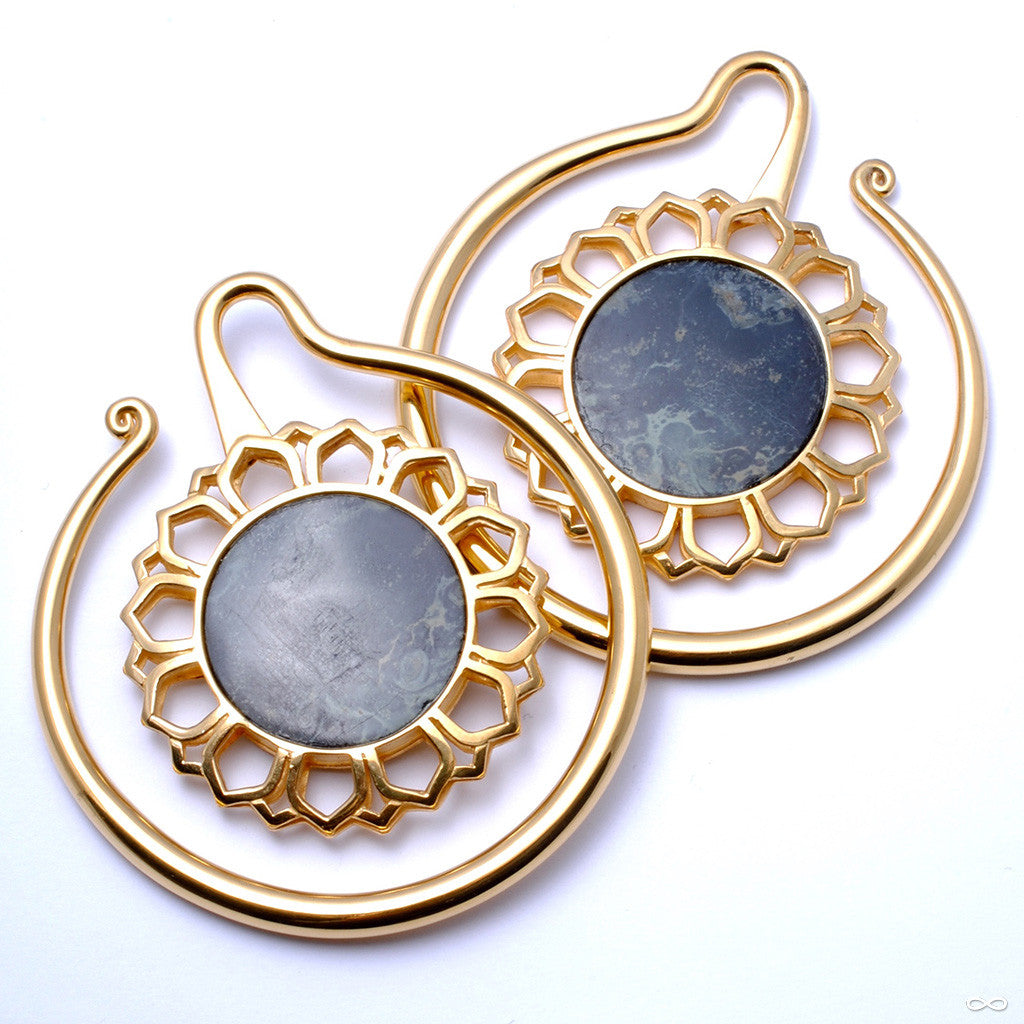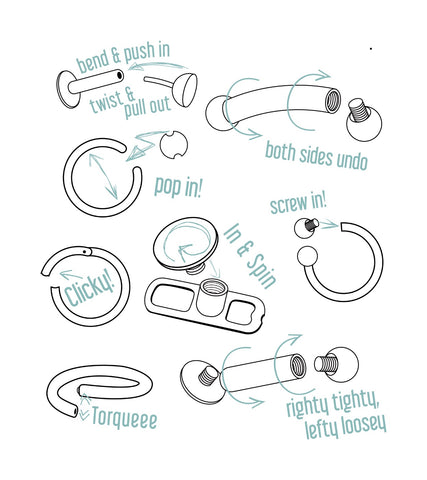 From press-fit posts to weights and captive bead rings, there are many different types of ornamentation considered “body jewelry.” What follows are the various types of jewelry you’ll encounter at our studio (or any other), a bit of information about how each one works, and basic instructions on how to insert and/or remove them.
From press-fit posts to weights and captive bead rings, there are many different types of ornamentation considered “body jewelry.” What follows are the various types of jewelry you’ll encounter at our studio (or any other), a bit of information about how each one works, and basic instructions on how to insert and/or remove them.
Keep in mind, we are always happy to help you change your jewelry at the studio. (Just remember to bring your ID every time and arrive one hour prior to closing!) But even if you usually come to us for your jewelry change, it’s a good idea to figure out how your jewelry works—unexpected emergency room trips or medical procedures may require body jewelry be removed, and we hear all too often the difficulty people encounter trying to take jewelry out in an emergency without understanding exactly how it works.
Image above courtesy of Joeltron!
Press-fit Jewelry
Press-fit posts, commonly referred to as threadless or push-pin posts, were developed (and patented) by NeoMetal. Press-fit barbells and curved barbells are currently available in 18 gauge and 16 gauge sizes, so you’ll see these used mainly for ear and nostril piercings, while 14 gauge press-fit labret posts are a popular option for lip, labret, and beauty mark piercings.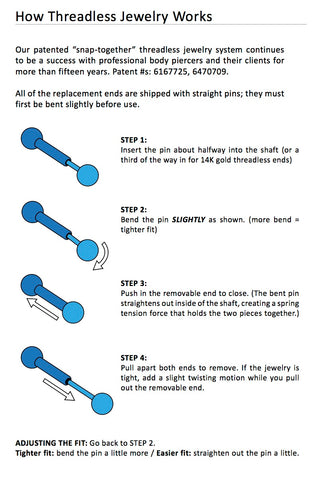 Press-fit jewelry consists of two pieces: a post with an attached ball (or disk) and a ball or ornamental end that “press-fits” into the post. These posts are some of the easiest jewelry to remove, as the two ends simply pull apart. Get a good grip on both ends with your fingers, and pull. It’s that easy! Press-fit jewelry can also be adjusted for tightness, as illustrated below.
Press-fit jewelry consists of two pieces: a post with an attached ball (or disk) and a ball or ornamental end that “press-fits” into the post. These posts are some of the easiest jewelry to remove, as the two ends simply pull apart. Get a good grip on both ends with your fingers, and pull. It’s that easy! Press-fit jewelry can also be adjusted for tightness, as illustrated below.
One of the benefits of press-fit posts is that you have the ability to quickly and easily change pieces. Instead of buying entirely new jewelry, you can change your look by purchasing a new gem end. For more information on shopping for and changing this type of jewelry, see our Press-fit Jewelry page.
If your jewelry doesn’t pull apart, and instead unscrews, then you most likely have threaded jewelry.
Threaded Jewelry
Straight, Curved, and Circular Barbells (and Labrets)
Unlike press-fit posts, threaded jewelry has one end (or both) that unscrews for removal. Just twist the ball like you would a screw or any other container or closure (righty-tighty; lefty-loosey). You’ll find threaded jewelry most often in nipple piercings and navel piercings, along with vertical hood piercings, and other vulva and penis piercings.
Body jewelry will typically have one of two types of threading:
- Internally threaded jewelry is jewelry where the ball has a threaded post that sticks out, and this screws into a hollow-end barbell. With this type of threading, the part that passes through your skin is smooth and doesn’t scrape or injure the tissue as it passes through. (This is especially important with fresh piercings.) This is the type of threading recommended by the Association of Professional Piercers in their Minimum Standards for Jewelry for Initial Piercings.
-
Externally threaded jewelry has screw threading (or screw pattern) cut into the outside of the bar, with a hollowed-end ball that threads onto it. This means that instead of a smooth piece passing through your skin, a relatively rough surface must go through the tissue every time you insert and remove the jewelry. We don’t use externally threaded jewelry, and its use in initial piercings is prohibited inside Philadelphia.
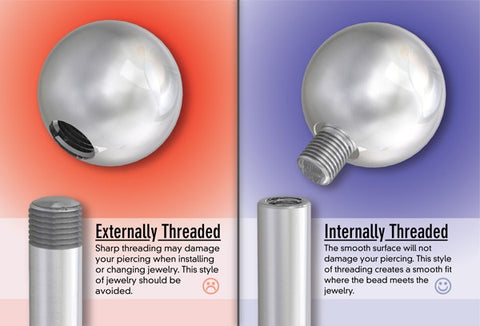
Image courtesy Brian Skellie.
Keep in mind that threaded ends can become loose over time. Check the ends on your jewelry occasionally to make sure the ends are still tightly attached. (On fancy navel curves, it’s usually the top ball that unscrews.)
Rings
Captive bead rings and Segment Rings
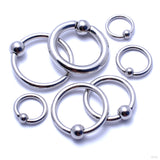 Captive bead rings are often referred to as CBRs or “captives” because the bead is held in place by the tension of the ring. Neither end is attached to the bead; instead, the bead remains suspended between the two ends of the ring. This means that you also have the option of changing just the bead. In some cases you can do this yourself; however, in some other instances tools may be needed to open or close captive bead rings, especially those which are thicker or smaller in diameter.
Captive bead rings are often referred to as CBRs or “captives” because the bead is held in place by the tension of the ring. Neither end is attached to the bead; instead, the bead remains suspended between the two ends of the ring. This means that you also have the option of changing just the bead. In some cases you can do this yourself; however, in some other instances tools may be needed to open or close captive bead rings, especially those which are thicker or smaller in diameter.
In order to open and remove a captive bead ring, grasp the ring with your thumb and forefinger while using your other hand to grab the bead itself. Gently pull the ring and bead in opposite directions until the bead pops out. A small space will remain where the bead was. For thinner jewelry, this space can be enlarged simply by bending the ring. (Be sure to twist; don’t spread!) Thicker jewelry can be difficult to bend open, so it’s usually best just to insert or remove as-is.
 Segment rings are similar to captive bead rings, but instead of a bead popping out, a segment of the ring itself unsnaps. These are popular in septum piercings, as they are more practical than a seam ring if the jewelry must be removed frequently. Larger sizes are sometimes suitable for other piercings, but are usually not used for initial piercings, as the seam can spin through the piercing and set back healing.
Segment rings are similar to captive bead rings, but instead of a bead popping out, a segment of the ring itself unsnaps. These are popular in septum piercings, as they are more practical than a seam ring if the jewelry must be removed frequently. Larger sizes are sometimes suitable for other piercings, but are usually not used for initial piercings, as the seam can spin through the piercing and set back healing.
Fixed Bead Rings and Seam Rings
 Unlike captive bead rings—where the bead is held in place by tension—with fixed bead rings the bead is attached (or fixed) to one side of the ring. In order to get the ring open you need to bend it. To do this, imagine you’re tearing a piece of paper in two: grasp the ring on each side of the bead and push one end away from you while pulling the other end toward you. Twist, don’t spread the ring open by simply pull the ends apart, as once a ring is no longer round it’s hard to get it back into shape. The beadless variation, referred to as a seam ring or continuous ring, also opens using this same twisting method.
Unlike captive bead rings—where the bead is held in place by tension—with fixed bead rings the bead is attached (or fixed) to one side of the ring. In order to get the ring open you need to bend it. To do this, imagine you’re tearing a piece of paper in two: grasp the ring on each side of the bead and push one end away from you while pulling the other end toward you. Twist, don’t spread the ring open by simply pull the ends apart, as once a ring is no longer round it’s hard to get it back into shape. The beadless variation, referred to as a seam ring or continuous ring, also opens using this same twisting method.
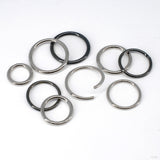 Seam rings, sometimes referred to as “seamless” or “continuous” rings, do have a seam but it is less visible than with captive or fixed bead rings. These are not recommended for piercings where the jewelry is changed often, and because the seam can spin through the skin of the piercing, this jewelry is also not suggested for during the healing period.
Seam rings, sometimes referred to as “seamless” or “continuous” rings, do have a seam but it is less visible than with captive or fixed bead rings. These are not recommended for piercings where the jewelry is changed often, and because the seam can spin through the skin of the piercing, this jewelry is also not suggested for during the healing period.
Clickers and Hinged Rings
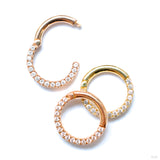
Nostril Screws, Nostril Nails and Septum Retainers
Nostril screws, nostril retainers, and septum retainers are pieces held in place solely by their shape; nostril screws are held in place by an attached end and a bend in the post while septum retainers stay in place because of their staple-like design; nostril nails are a combination of the two and are held in place both by their round shape as well as one attached end.
Nostril screws are (as the name implies) specific to nostril piercings. They are usually 20 gauge or 18 gauge thick with a ball, disc, or gem on one end, and are usually about ¾” long unbent. These are held in place by the bend on the post and are removed by grabbing the end and pulling the post out while giving a slight twist—it is literally like “unscrewing” the jewelry. Though nostril screws are sometimes sold pre-bent, nostril screws should really be fit the individual; for this reason we do not offer them in our online store.
 Nostril nails are designed to give the look of wearing a ring, but without the hassle that can come along with changing rings. They are available with different types of attached or fixed ends including discs, gems, and more decorative designs. Because they are only held in place securely on one end, they are not recommended for healing piercings.
Nostril nails are designed to give the look of wearing a ring, but without the hassle that can come along with changing rings. They are available with different types of attached or fixed ends including discs, gems, and more decorative designs. Because they are only held in place securely on one end, they are not recommended for healing piercings.
 Septum retainers allow for something to be worn in septum piercings when the jewelry (and piercing) needs to be hidden. These are shaped like a square-bottom “U” and are available in a polished or matte finish. They can be worn down or flipped up inside the septum when discretion is required.
Septum retainers allow for something to be worn in septum piercings when the jewelry (and piercing) needs to be hidden. These are shaped like a square-bottom “U” and are available in a polished or matte finish. They can be worn down or flipped up inside the septum when discretion is required.
Surface Bars & Anchors
While both surface bars and surface anchors pierce sections of the body where other jewelry types wouldn’t work: flat surfaces. Each has its own design and application.
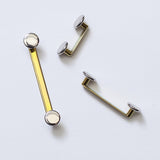 Surface bars are staple-shaped pieces of jewelry that are used specifically for flat surface piercings (think your hips or the back of your neck). The "uplifts" on the ends are of varying length, depending on the thickness of the tissue in the area being pierced. While various types of ends can be threaded onto the bar, flat discs are usually your best option, at least for healing. Surface bars, and even just the ends, can be difficult to change or remove without help from a piercer, so it’s usually best to stop by our shop (or a shop in your area) for assistance. For more information, check out our page on surface piercings.
Surface bars are staple-shaped pieces of jewelry that are used specifically for flat surface piercings (think your hips or the back of your neck). The "uplifts" on the ends are of varying length, depending on the thickness of the tissue in the area being pierced. While various types of ends can be threaded onto the bar, flat discs are usually your best option, at least for healing. Surface bars, and even just the ends, can be difficult to change or remove without help from a piercer, so it’s usually best to stop by our shop (or a shop in your area) for assistance. For more information, check out our page on surface piercings.
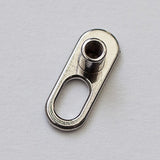 Also referred to as dermal anchors, microdermals, or single-point piercings, surface anchors are composed of two pieces: a threaded end top (the visible part of the jewelry), and the base (the part under the skin). While there are various types of bases available, ours are manufactured from implant-grade titanium and consist of a threaded post attached to a flat “foot” that sits under the skin. (Tops, however, can come in a wide variety of materials, from steel and titanium to yellow, white, and rose gold.) Different lengths of posts, or “uplifts,” are used for different skin types and different areas of the body; the appropriate length will be determined by your piercer. While the base stays in place for the life of the piercing, the ends can be changed. We don’t recommend you change or remove your anchor at home, as this can be difficult at best, and at worst can cause unnecessary trauma to the skin that can even result in the loss of your piercing. Stop by our shop (or a shop in your area) for assistance from a piercing professional. Your piercing will thank you!
Also referred to as dermal anchors, microdermals, or single-point piercings, surface anchors are composed of two pieces: a threaded end top (the visible part of the jewelry), and the base (the part under the skin). While there are various types of bases available, ours are manufactured from implant-grade titanium and consist of a threaded post attached to a flat “foot” that sits under the skin. (Tops, however, can come in a wide variety of materials, from steel and titanium to yellow, white, and rose gold.) Different lengths of posts, or “uplifts,” are used for different skin types and different areas of the body; the appropriate length will be determined by your piercer. While the base stays in place for the life of the piercing, the ends can be changed. We don’t recommend you change or remove your anchor at home, as this can be difficult at best, and at worst can cause unnecessary trauma to the skin that can even result in the loss of your piercing. Stop by our shop (or a shop in your area) for assistance from a piercing professional. Your piercing will thank you!
For more information, check out our page on surface anchors.
Jewelry for Stretched Piercings
When stretching piercings, especially ear piercings, there comes a time and size when traditional metal jewelry (i.e. rings and posts) is no longer appropriate, as enlarged piercings will often need a less-heavy alternative. Below are some of the different styles that can be worn in stretched piercings.
Plugs and Eyelets
The most basic type of jewelry for stretched ears are plugs (sometimes referred to as “gauges”) which are available in one of three styles: straight (or non-flared), single-flared, and double-flared. Straight, non-flared plugs are the same diameter for the entire length of the plug and are usually held in place by o-rings on either end. Double-flared plugs are “saddle-shaped,” meaning they are wider at the ends—flared—so the plugs stay in place on their own. Single-flared plugs, unlike their double-flared counterpart, are wider only on one end (the front) and are secured by an o-ring on the back. (Note: o-rings are most often made from one of two materials: synthetic rubber or silicone. Black o-rings, made of a synthetic rubber, can be irritating in piercings that are healing or freshly stretched, while clear, silicone o-rings have less chance of irritating your piercing. If given the choice, go with silicone.)
Eyelets, or tunnels, are the hollow versions of plugs with a hollowed out center. For those still looking for the look (and feel) of metal, steel, and titanium eyelets are the obvious choice.
When looking for plugs to stretch with, go with either a straight or single-flared design. It is not advisable to stretch with double-flared plugs, as this often means stretching two jewelry sizes at once—and comes with a good chance of tearing your piercing. There is also a chance that double-flared jewelry will get stuck; as a general rule, avoid double-flared jewelry until your piercing is healed. For more information on stretching piercings, check out our pages on stretching piercings: Methods, Troubleshooting, Tips, and Frequently Asked Questions.
Plugs and eyelets are available in several materials that are safe to wear in a healing stretched piercing. For plugs, single-flared glass Color Front Plugs from Gorilla Glass are one of our most popular styles of jewelry to stretch with, while glass and titanium eyelets are available for those who prefer a more open look. For more information about different types of plugs, see our Jewelry Materials page.
Hanging Designs and Weights
Hanging designs and weights are worn in stretched ear piercings and are larger and often more ornate than standard rings. These can be made out of lighter-weight materials like wood, horn or bone; inert materials like steel or glass; or weightier metals like silver, brass, or bronze. Most hanging designs and weights are designed with balance in mind, so the piece can be worn securely without falling out, and can easily be inserted or removed for short-term wear. While weights have become increasingly popular, they are not typically used during the stretching process, as they don’t tend to help increase the size of the piercing.
Large Labrets
 For large-gauge labrets (such as in horn, glass, or stone), jewelry is usually a single-piece, consisting of a straight post with a disc or flat “wings” on the end. These are made specifically for stretched lip piercings.
For large-gauge labrets (such as in horn, glass, or stone), jewelry is usually a single-piece, consisting of a straight post with a disc or flat “wings” on the end. These are made specifically for stretched lip piercings.
